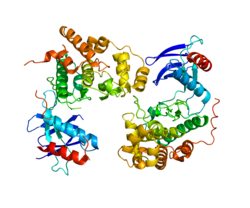| MAPK9 |
|---|
 |
| Available structures |
|---|
| PDB | Ortholog search: PDBe RCSB |
|---|
| List of PDB id codes |
|---|
3E7O, 3NPC |
|
|
| Identifiers |
|---|
| Aliases | MAPK9, JNK-55, JNK2, JNK2A, JNK2ALPHA, JNK2B, JNK2BETA, PRKM9, SAPK, SAPK1a, p54a, p54aSAPK, mitogen-activated protein kinase 9 |
|---|
| External IDs | OMIM: 602896; MGI: 1346862; HomoloGene: 55685; GeneCards: MAPK9; OMA:MAPK9 - orthologs |
|---|
| Gene location (Human) |
|---|
 | | Chr. | Chromosome 5 (human)[1] |
|---|
| | Band | 5q35.3 | Start | 180,233,143 bp[1] |
|---|
| End | 180,292,099 bp[1] |
|---|
|
| Gene location (Mouse) |
|---|
 | | Chr. | Chromosome 11 (mouse)[2] |
|---|
| | Band | 11|11 B1.2 | Start | 49,737,578 bp[2] |
|---|
| End | 49,777,248 bp[2] |
|---|
|
| RNA expression pattern |
|---|
| Bgee | | Human | Mouse (ortholog) |
|---|
| Top expressed in | - middle temporal gyrus
- Brodmann area 23
- cerebellar cortex
- cerebellar hemisphere
- superior frontal gyrus
- prefrontal cortex
- pons
- dorsolateral prefrontal cortex
- parietal lobe
- postcentral gyrus
|
| | Top expressed in | - dorsomedial hypothalamic nucleus
- atrioventricular valve
- cerebellar cortex
- superior frontal gyrus
- parotid gland
- medial vestibular nucleus
- submandibular gland
- lateral hypothalamus
- ventral tegmental area
- mammillary body
|
| | More reference expression data |
|
|---|
| BioGPS | 
 | | More reference expression data |
|
|---|
|
| Gene ontology |
|---|
| Molecular function | - transferase activity
- nucleotide binding
- protein kinase activity
- MAP kinase activity
- kinase activity
- protein serine/threonine kinase activity
- protein binding
- ATP binding
- transcription factor binding
- JUN kinase activity
- protein serine/threonine/tyrosine kinase activity
| | Cellular component | - cytosol
- nucleoplasm
- mitochondrion
- nucleus
- cytoplasm
- neuron projection
| | Biological process | - response to cadmium ion
- phosphorylation
- rhythmic process
- positive regulation of apoptotic signaling pathway
- positive regulation of podosome assembly
- Fc-epsilon receptor signaling pathway
- protein phosphorylation
- positive regulation of macrophage derived foam cell differentiation
- positive regulation of gene expression
- JUN phosphorylation
- regulation of circadian rhythm
- JNK cascade
- response to mechanical stimulus
- positive regulation of apoptotic process
- neuron development
- cellular response to organic substance
- protein localization to tricellular tight junction
- cellular response to reactive oxygen species
- cellular response to cadmium ion
- peptidyl-serine phosphorylation
- positive regulation of protein ubiquitination
- positive regulation of transcription factor catabolic process
- regulation of gene expression
- intracellular signal transduction
- regulation of DNA-binding transcription factor activity
| | Sources:Amigo / QuickGO |
|
| Orthologs |
|---|
| Species | Human | Mouse |
|---|
| Entrez | | |
|---|
| Ensembl | | |
|---|
| UniProt | | |
|---|
| RefSeq (mRNA) | NM_001135044
NM_001308244
NM_002752
NM_139068
NM_139069
|
|---|
NM_139070
NM_001364607
NM_001364608
NM_001364609
NM_001364610
NM_001364611
NM_001364612
NM_001364613 |
| |
|---|
NM_001163671
NM_001163672
NM_016961
NM_207692 |
|
|---|
| RefSeq (protein) | NP_001128516
NP_001295173
NP_002743
NP_620707
NP_620708
|
|---|
NP_620709
NP_001351536
NP_001351537
NP_001351538
NP_001351539
NP_001351540
NP_001351541
NP_001351542 |
| |
|---|
NP_001157143
NP_001157144
NP_058657
NP_997575 |
|
|---|
| Location (UCSC) | Chr 5: 180.23 – 180.29 Mb | Chr 11: 49.74 – 49.78 Mb |
|---|
| PubMed search | [3] | [4] |
|---|
|
| Wikidata |
| View/Edit Human | View/Edit Mouse |
|





















